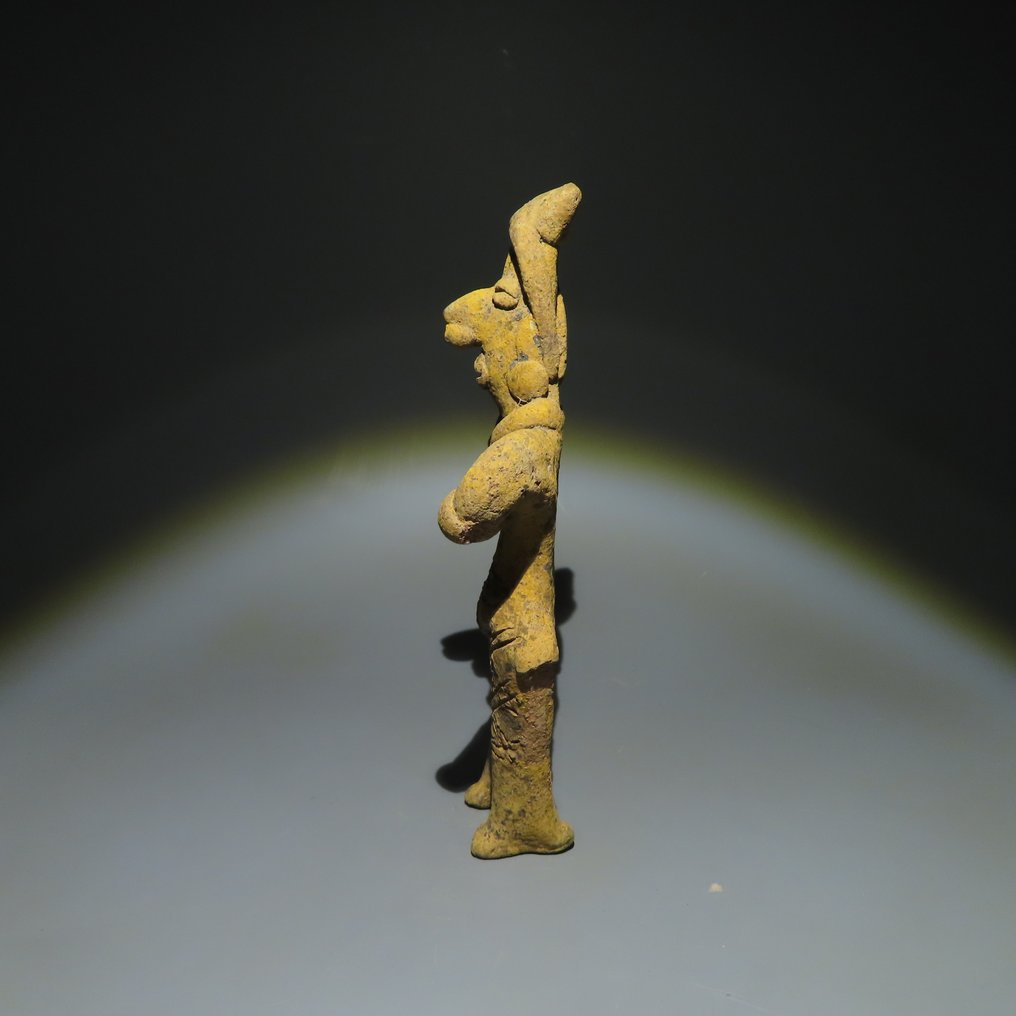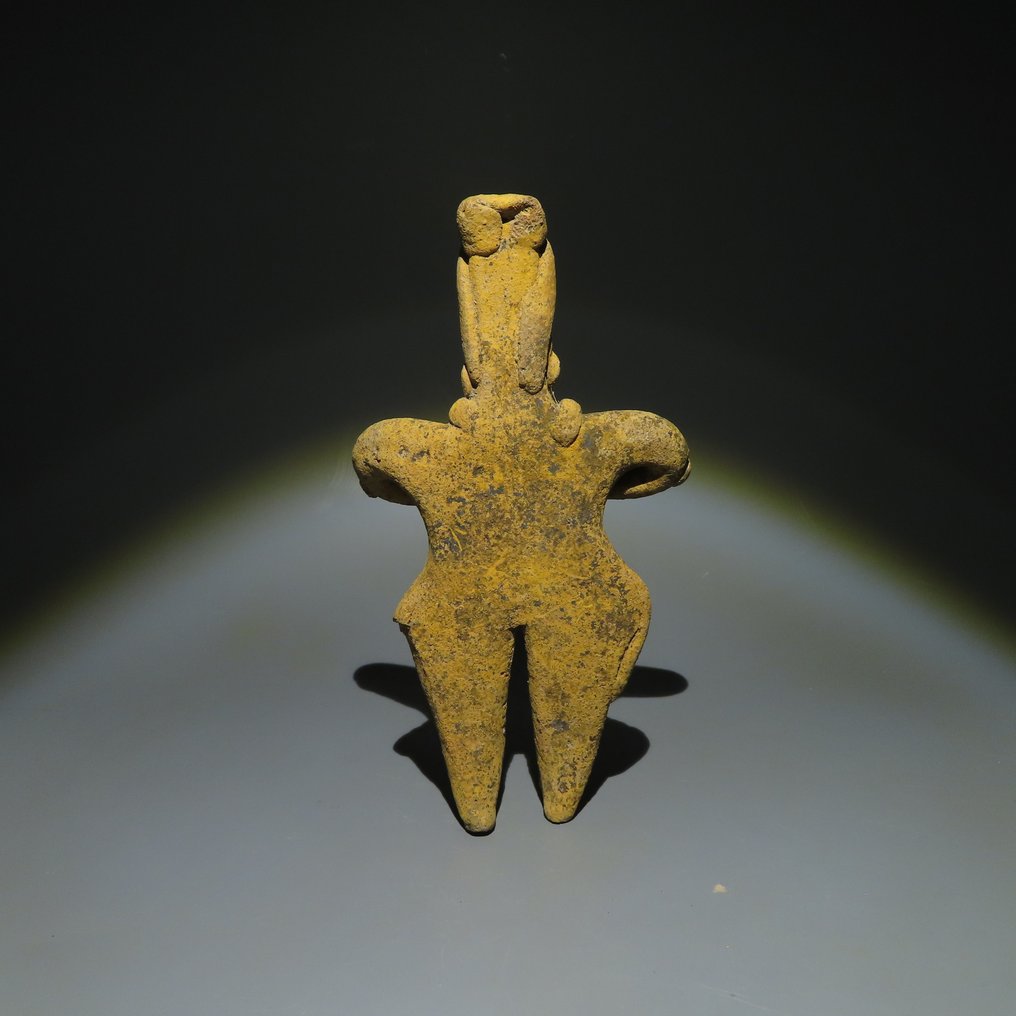a recommander envoi tres rapide est sécurisé embalage tres bien fait vraiment rien a dire plus que parfait
Vertaling bekijkenColima, West-Mexico Terracotta Colima, West-Mexico, figuur. 200 v.Chr. - 500 n.Chr. 19,5 cm hoog. Spaanse importvergunning.
Nr. 88999161



Figure
CULTURE: Colima, Western Mexico
PERIOD: 200 BC - 500 AD
MATERIAL: Terracotta
DIMENSIONS: 19,5 cm H.
PROVENANCE: Private collection, Ex. Dr. David Harner, Arkansas, United States of America, Acquired between 1950 - 1960.
CONDITION: Good condition.
DESCRIPTION:
The Colima people lived in northwest Mexico, in a rugged, low-lying coastal region carved by valleys, each with its own ecology and a warm, humid climate.
Little is known about their modes of subsistence, as most of the information we have comes from artifacts from private collections and from the excavation of cemeteries, not residential sites, which usually provide this kind of information. We do know that they practiced irrigation farming, which allowed them to live in large groups in relatively independent villages and urban centers.
Colima ceramics display a wide variety of figures and shapes, but little variation in technique. Most pieces have a burnished red finish and some are decorated with orange or white incisions. Molded figures are common, especially of plants, animals (especially dogs) and seashells. Human representations typically feature dwarfs and hunchbacks more than others, and few female forms. Many of these figures have “coffee-bean” eyes and are dressed in finely detailed traditional attire. Little is known of Colima stonework; only a few pieces such as mace heads, small masks and figurines have been found. These people also practiced basketweaving and weaving, and used metallurgy to make objects such as needles, axes, rattles, nose rings and ear ornaments.
Little is known about the Colima’s social order, but shamans or priests may have occupied positions of social importance. The existence of figurines resembling warriors as well as prisoners with hands tied points to the ceremonial importance of war in this pre-Columbian society.
The vast majority of ceramic pieces that have been ascribed to this culture are grave goods found in the tombs of individuals of high social rank. The Colima buried their dead in family tombs up to 30 meters deep, some with multiple chambers. The bodies were accompanied by a wide variety of grave goods, including ceramic statuettes of armed men, which served as symbolic guardians. Ceramic sculptures of dogs were another common grave good, and were believed to be the emissaries of Xolotl, the god of death.
The history of the Colima people is not well known, but, like many Mesoamerican cultures, the Colima displayed some stylistic elements that links them with the ancient Olmecs.
Notes:
- The piece includes authenticity certificate.
- The piece includes Spanish Export License.
- The seller guarantees that he acquired this piece according to all national and international laws related to the ownership of cultural property. Provenance statement seen by Catawiki.
De verkoper stelt zich voor
Figure
CULTURE: Colima, Western Mexico
PERIOD: 200 BC - 500 AD
MATERIAL: Terracotta
DIMENSIONS: 19,5 cm H.
PROVENANCE: Private collection, Ex. Dr. David Harner, Arkansas, United States of America, Acquired between 1950 - 1960.
CONDITION: Good condition.
DESCRIPTION:
The Colima people lived in northwest Mexico, in a rugged, low-lying coastal region carved by valleys, each with its own ecology and a warm, humid climate.
Little is known about their modes of subsistence, as most of the information we have comes from artifacts from private collections and from the excavation of cemeteries, not residential sites, which usually provide this kind of information. We do know that they practiced irrigation farming, which allowed them to live in large groups in relatively independent villages and urban centers.
Colima ceramics display a wide variety of figures and shapes, but little variation in technique. Most pieces have a burnished red finish and some are decorated with orange or white incisions. Molded figures are common, especially of plants, animals (especially dogs) and seashells. Human representations typically feature dwarfs and hunchbacks more than others, and few female forms. Many of these figures have “coffee-bean” eyes and are dressed in finely detailed traditional attire. Little is known of Colima stonework; only a few pieces such as mace heads, small masks and figurines have been found. These people also practiced basketweaving and weaving, and used metallurgy to make objects such as needles, axes, rattles, nose rings and ear ornaments.
Little is known about the Colima’s social order, but shamans or priests may have occupied positions of social importance. The existence of figurines resembling warriors as well as prisoners with hands tied points to the ceremonial importance of war in this pre-Columbian society.
The vast majority of ceramic pieces that have been ascribed to this culture are grave goods found in the tombs of individuals of high social rank. The Colima buried their dead in family tombs up to 30 meters deep, some with multiple chambers. The bodies were accompanied by a wide variety of grave goods, including ceramic statuettes of armed men, which served as symbolic guardians. Ceramic sculptures of dogs were another common grave good, and were believed to be the emissaries of Xolotl, the god of death.
The history of the Colima people is not well known, but, like many Mesoamerican cultures, the Colima displayed some stylistic elements that links them with the ancient Olmecs.
Notes:
- The piece includes authenticity certificate.
- The piece includes Spanish Export License.
- The seller guarantees that he acquired this piece according to all national and international laws related to the ownership of cultural property. Provenance statement seen by Catawiki.
De verkoper stelt zich voor
- 827
- 9
- 2
Beautiful objects! Extremely fast shipment! I can fully recommend this seller.
Vertaling bekijkenwonderful apis!very fast shipping!thanks a lot
Vertaling bekijkenpezzo bellissimo, e spedito a tempo record, venditore veloce onesto e preciso, consigliatissimo. Grazie
Vertaling bekijkenAlways a great pleasure !
Vertaling bekijkenEnvíos siempre con cuidado
Vertaling bekijkenBuen vendedor
Vertaling bekijkenObjekte wie abgebildet, das Gefäss sogar noch schöner / unkomplizierter Versand und sehr gut verpackt. Perfekte Transaktion!!
Vertaling bekijkensuperb, as usual
Vertaling bekijkenGreat object, fast delivery
Vertaling bekijkenProfessional seller. Object received s described. Fair price
Vertaling bekijkenPagas y no recibes el producto.
Vertaling bekijkenWell packed, fast delivery. Arrived safely, in good condition. Thank you!
Vertaling bekijkenDanke!
Vertaling bekijkenLa pieza se corresponde con la ofertada. Envio perfecto. Con todos los certificados y factura. Un diez de vendedor. Muchas gracias.
Vertaling bekijkenone more nice piece thank you!
Vertaling bekijkenbellissimo grazie top 💯💯💯💯💯
Vertaling bekijkenWell packed, very nice little oil lamp, never seen such one before!
Vertaling bekijkenEs ist alles top gelaufen. Mir wurde das Artefakt super verpackt und schnell zugesandt. Vielen Dank
Vertaling bekijkenPrompt shipping, great packaging. Thank you very much.
Vertaling bekijkenBien !
Vertaling bekijkenTodo ok ….gracias .
Vertaling bekijkenEnvio rápido y muy correcto, muy bien protegido. Con todos los certificados y documentación. Excelente servicio.
Vertaling bekijkenTrès beaux objets archéologiques. Emballage parfait. Livraison express. Merci beaucoup. Gracias.
Vertaling bekijkenall good.
Vertaling bekijken- 827
- 9
- 2
a recommander envoi tres rapide est sécurisé embalage tres bien fait vraiment rien a dire plus que parfait
Vertaling bekijkenDisclaimer
De verkoper garandeert dat het object legaal is verkregen en kan dit bewijzen. Catawiki heeft de verkoper geïnformeerd dat hij/zij documentatie moet overleggen die vereist is volgens de wetten in hun land van verblijf. De verkoper garandeert dat hij/zij toestemming heeft om het object te verkopen/exporteren. De verkoper zal alle over het object bekende herkomstgegevens aan de koper verstrekken. De verkoper zorgt ervoor dat eventueel benodigde vergunningen zijn/zullen worden geregeld. De verkoper zal de koper onmiddellijk informeren over eventuele vertragingen bij het verkrijgen van dergelijke vergunningen.
De verkoper garandeert dat het object legaal is verkregen en kan dit bewijzen. Catawiki heeft de verkoper geïnformeerd dat hij/zij documentatie moet overleggen die vereist is volgens de wetten in hun land van verblijf. De verkoper garandeert dat hij/zij toestemming heeft om het object te verkopen/exporteren. De verkoper zal alle over het object bekende herkomstgegevens aan de koper verstrekken. De verkoper zorgt ervoor dat eventueel benodigde vergunningen zijn/zullen worden geregeld. De verkoper zal de koper onmiddellijk informeren over eventuele vertragingen bij het verkrijgen van dergelijke vergunningen.








